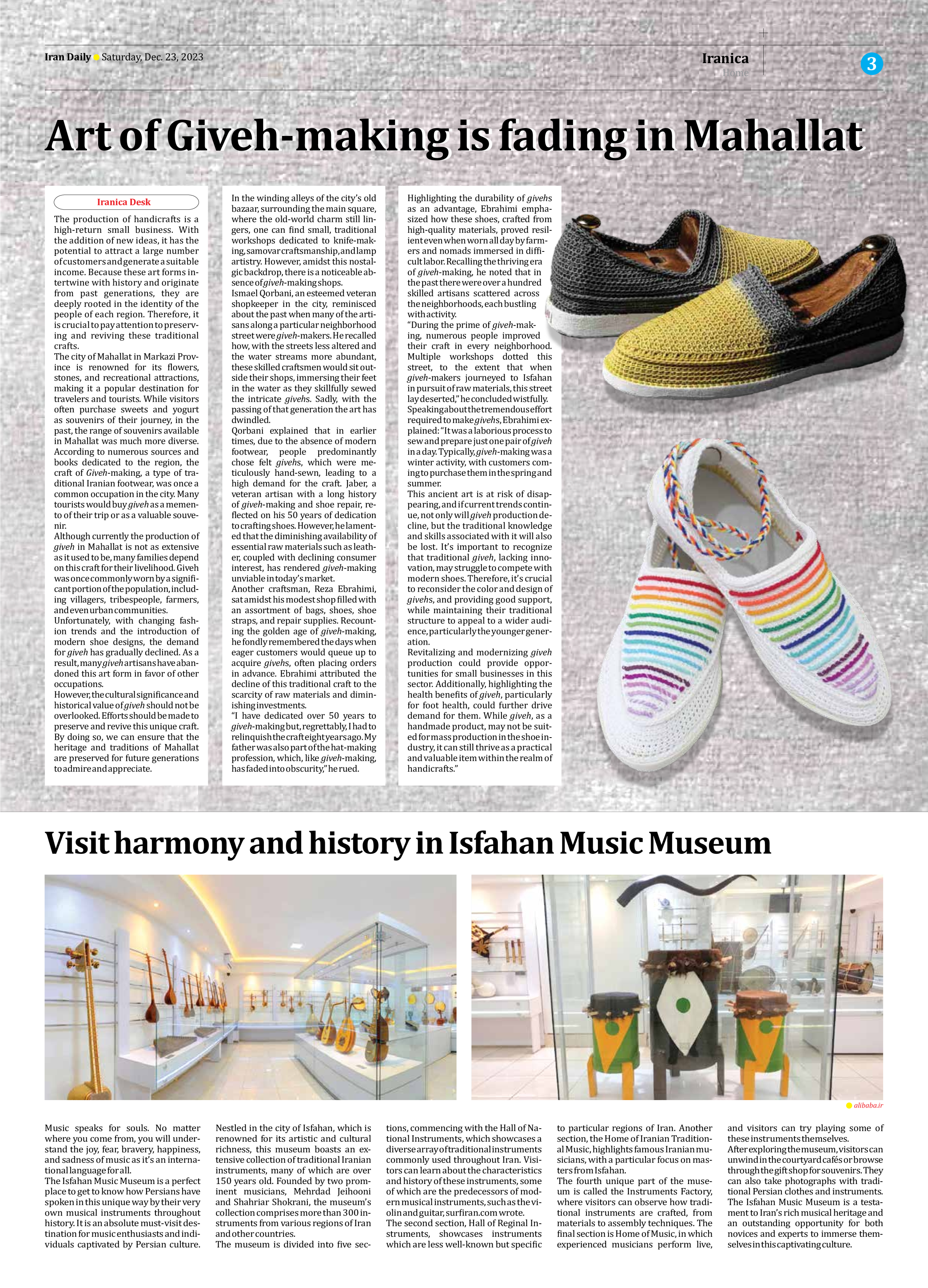
Art of Giveh-making is fading in Mahallat
The production of handicrafts is a high-return small business. With the addition of new ideas, it has the potential to attract a large number of customers and generate a suitable income. Because these art forms intertwine with history and originate from past generations, they are deeply rooted in the identity of the people of each region. Therefore, it is crucial to pay attention to preserving and reviving these traditional crafts.
The city of Mahallat in Markazi Province is renowned for its flowers, stones, and recreational attractions, making it a popular destination for travelers and tourists. While visitors often purchase sweets and yogurt as souvenirs of their journey, in the past, the range of souvenirs available in Mahallat was much more diverse. According to numerous sources and books dedicated to the region, the craft of Giveh-making, a type of traditional Iranian footwear, was once a common occupation in the city. Many tourists would buy giveh as a memento of their trip or as a valuable souvenir.
Although currently the production of giveh in Mahallat is not as extensive as it used to be, many families depend on this craft for their livelihood. Giveh was once commonly worn by a significant portion of the population, including villagers, tribespeople, farmers, and even urban communities.
Unfortunately, with changing fashion trends and the introduction of modern shoe designs, the demand for giveh has gradually declined. As a result, many giveh artisans have abandoned this art form in favor of other occupations.
However, the cultural significance and historical value of giveh should not be overlooked. Efforts should be made to preserve and revive this unique craft. By doing so, we can ensure that the heritage and traditions of Mahallat are preserved for future generations to admire and appreciate.
In the winding alleys of the city’s old bazaar, surrounding the main square, where the old-world charm still lingers, one can find small, traditional workshops dedicated to knife-making, samovar craftsmanship, and lamp artistry. However, amidst this nostalgic backdrop, there is a noticeable absence of giveh-making shops.
Ismael Qorbani, an esteemed veteran shopkeeper in the city, reminisced about the past when many of the artisans along a particular neighborhood street were giveh-makers. He recalled how, with the streets less altered and the water streams more abundant, these skilled craftsmen would sit outside their shops, immersing their feet in the water as they skillfully sewed the intricate givehs. Sadly, with the passing of that generation the art has dwindled.
Qorbani explained that in earlier times, due to the absence of modern footwear, people predominantly chose felt givehs, which were meticulously hand-sewn, leading to a high demand for the craft. Jaber, a veteran artisan with a long history of giveh-making and shoe repair, reflected on his 50 years of dedication to crafting shoes. However, he lamented that the diminishing availability of essential raw materials such as leather, coupled with declining consumer interest, has rendered giveh-making unviable in today’s market.
Another craftsman, Reza Ebrahimi, sat amidst his modest shop filled with an assortment of bags, shoes, shoe straps, and repair supplies. Recounting the golden age of giveh-making, he fondly remembered the days when eager customers would queue up to acquire givehs, often placing orders in advance. Ebrahimi attributed the decline of this traditional craft to the scarcity of raw materials and diminishing investments.
“I have dedicated over 50 years to giveh-making but, regrettably, I had to relinquish the craft eight years ago. My father was also part of the hat-making profession, which, like giveh-making, has faded into obscurity,” he rued.
Highlighting the durability of givehs as an advantage, Ebrahimi emphasized how these shoes, crafted from high-quality materials, proved resilient even when worn all day by farmers and nomads immersed in difficult labor. Recalling the thriving era of giveh-making, he noted that in the past there were over a hundred skilled artisans scattered across the neighborhoods, each bustling with activity.
“During the prime of giveh-making, numerous people improved their craft in every neighborhood. Multiple workshops dotted this street, to the extent that when giveh-makers journeyed to Isfahan in pursuit of raw materials, this street lay deserted,” he concluded wistfully.
Speaking about the tremendous effort required to make givehs, Ebrahimi explained: “It was a laborious process to sew and prepare just one pair of giveh in a day. Typically, giveh-making was a winter activity, with customers coming to purchase them in the spring and summer.
This ancient art is at risk of disappearing, and if current trends continue, not only will giveh production decline, but the traditional knowledge and skills associated with it will also be lost. It’s important to recognize that traditional giveh, lacking innovation, may struggle to compete with modern shoes. Therefore, it’s crucial to reconsider the color and design of givehs, and providing good support, while maintaining their traditional structure to appeal to a wider audience, particularly the younger generation.
Revitalizing and modernizing giveh production could provide opportunities for small businesses in this sector. Additionally, highlighting the health benefits of giveh, particularly for foot health, could further drive demand for them. While giveh, as a handmade product, may not be suited for mass production in the shoe industry, it can still thrive as a practical and valuable item within the realm of handicrafts.”







